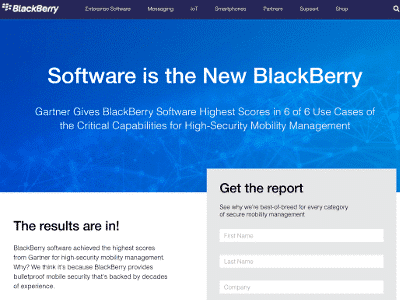
 At the 2016 TU-Automotive Conference and Exhibition in Detroit, BlackBerry (TSX:BB) (NASDAQ:BBRY) subsidiary QNX Software announced that its instrument cluster and QNX Acoustics for Voice software for hands-free voice communications, which allows a driver to talk to back-seat passengers without having to raise his voice or turn around, has shipped in over 50 million telematics and infotainment systems.
At the 2016 TU-Automotive Conference and Exhibition in Detroit, BlackBerry (TSX:BB) (NASDAQ:BBRY) subsidiary QNX Software announced that its instrument cluster and QNX Acoustics for Voice software for hands-free voice communications, which allows a driver to talk to back-seat passengers without having to raise his voice or turn around, has shipped in over 50 million telematics and infotainment systems.
The QNX Acoustics Management Platform offers patented algorithms for echo cancellation, noise reduction, and other other voice-enhancement technologies to enable clear voice communications in the sonic environment of a car, even if traveling at highway speeds.
“The quality of hands-free communications can make or break the driving experience, which is why so many automakers and tier one suppliers rely on QNX acoustics technology – it is engineered to enable the best possible UX, to eliminate the cost of dedicated hardware, and to simplify the tuning of complex acoustics systems,” said John Wall, Senior Vice President and Head of QNX Software Systems.
“Being deployed in over 50 million systems by nearly 20 automakers is a testament to the value that our acoustics expertise brings to the industry, and to the trust customers place in our production-proven technology.”
Those 20 leading automakers include Alfa Romeo, Audi, Corvette, Jaguar, and Range Rover, along with deployment in products which are now using QNX acoustics software to enhance the in-vehicle user experience, such as Chrysler Uconnect, Ford SYNC 3, GM OnStar and Honda BlueConnect.
At their convention booth, QNX showed off its advanced driver assistance systems (ADAS), instrument clusters, infotainment, automotive security, acoustics, smartphone integration, V2X, remote SIM management technologies, in a concept car based on the Toyota Highlande
__
QNX’s new Platform for Instrument Clusters allows instrument clusters with ISO 26262 safety requirements to leverage the power of accelerated 2D/3D graphics.
Digital instrument clusters are one of the fastest-growing segments in automotive electronics, display traditional instrument cluster information, such as speed and RPM, context-sensitive information, including turn-by-turn directions supplied by other vehicle subsystems, local speed limits, rearview camera video and collision warnings, all represented using sophisticated 2D and 3D graphics.
QNX has become the leading software supplier for vehicle infotainment systems, deployed in over 60 million cars.
The combined demand for hybrid and fully digital instrument clusters is set to increase from 8.7 million units in 2015 to 42.2 million by 2023, according to Strategy Analytics.
With its handset business floundering, QNX is one business BlackBerry really needs to work. Co-founder Mike Lazaridis, a noted car buff, went as far as to say “We see the car as the ultimate BlackBerry accessory,” when BlackBerry acquired the company six years ago.
Since then, QNX, whose technology can be found in numerous car brands, has kept its foot on the pedal. In January, at the Consumer Electronics Show (CES) in Las Vegas, BlackBerry unveiled the QNX 2015 concept car. Based on a Maserati Quattroporte, the vehicle demonstrated the integration of technologies that solve issues surrounding the deliver of content to the driver without distraction, the display of local speed limits, the integration of information from multiple screens into a single screen, and the expectation that touch screen technology, which users have become used to on tablet devices, can be most effectively be used in a dashboard interface.
Leave a Reply
You must be logged in to post a comment.





 Share
Share Tweet
Tweet Share
Share




Comment